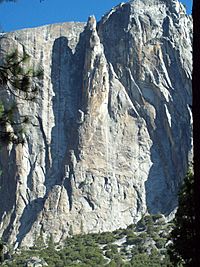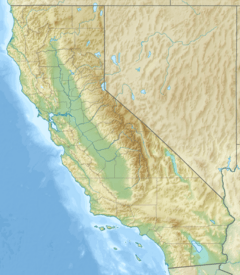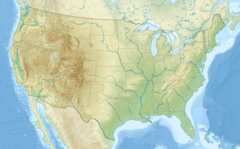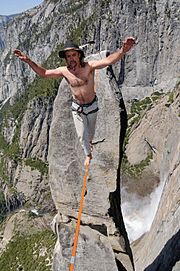Lost Arrow Spire facts for kids
Quick facts for kids Lost Arrow Spire |
|
|---|---|
 |
|
| Highest point | |
| Elevation | 6,930 ft (2,110 m) |
| Geography | |
| Location | Yosemite National Park |
| Parent range | Sierra Nevada |
| Geology | |
| Age of rock | Cretaceous |
| Mountain type | granite rock |
The Lost Arrow Spire is a tall, thin rock pillar in Yosemite National Park, California. It stands right next to the famous Upper Yosemite Falls. This amazing rock is known for its challenging climbing routes, especially the Lost Arrow Spire Chimney. This route is so famous, it's even in a special book called Fifty Classic Climbs of North America. It's also a popular spot for a thrilling activity called slacklining, where people walk across a tightrope-like line high above the ground.
Contents
Climbing the Spire
In 1946, the top of the spire was first reached in a very unusual way. Climbers threw a lasso (a rope with a loop) from the main valley wall, about 125 feet away, to catch the spire's tip. Then, 29-year-old Ax Nelson used a special climbing knot called a prusik to climb up the rope to the peak. Jack Arnold followed him.
A climbing historian named Steve Roper called this "one of the greatest rope stunts ever." However, many climbers didn't see it as a true rock climb. Nelson himself said it was "spectacular and effective," but it didn't require much actual climbing skill.
That same year, 48-year-old John Salathé, an immigrant from Switzerland, was also trying to climb the spire. He invented a much better piton (a metal spike used in climbing). His new pitons were made from the strong metal used in the Ford Model A car axles. This meant they could handle the hard granite rock of Yosemite without bending.
The Lost Arrow Spire Chimney Route
| Lost Arrow Spire Chimney | |
|---|---|
| Location | California, USA |
| Coordinates | 37°45′22″N 119°35′35″W / 37.75600°N 119.593°W |
| Climbing Area | Yosemite Valley |
| Route Type | Aid, Traditional |
| Vertical Gain | 1,400 feet |
| Pitches | 10 |
| Rating | 5.5 A3 or 5.10 A2 |
| First ascent | Salathé, Nelson, 1947. |
| First free ascent | Jerry Moffatt, 1985. |
In 1947, Ax Nelson and John Salathé teamed up. Using Salathé's new strong pitons, they made the first real climb of the Lost Arrow Spire Chimney. This route is rated 5.5 A3 or 5.10 A2. It combined two climbing styles: traditional climbing (using removable gear) and aid climbing (using gear to help you move up). It took them five days to complete this challenging climb.
This route is listed in the famous book Fifty Classic Climbs of North America and is considered a true classic. Steve Roper, a climbing historian, called this climb "a true Valley milestone." He said it was the first "big-wall" climb ever done in the United States. It marked the start of the "Golden Age" of climbing in Yosemite.
In June 1985, Jerry Moffatt made the first "free ascent" of the Lost Arrow Spire Chimney. This means he climbed it using only his hands and feet, without pulling on ropes or gear. He did this with Ron Kauk as a live television event for ABC's Wide World of Sports. Over 30 million people watched this amazing feat.
By 2022, two 6-year-olds had climbed this route! The first was American climber Tommy Caldwell, who climbed it in 1987 when he was six. The second was Sam Baker, who climbed it in 2020, also at age six.
The Lost Arrow Spire Tip
The last two sections, or pitches, of the Lost Arrow Spire Chimney route are called the Lost Arrow Spire Tip. This part completes the climb of the detached pillar. The first "free ascent" of the Tip was in 1984 by a team led by Dave Shultz.
Climbers often reach the Tip route by rappelling (sliding down a rope) into an area called The Notch. Once climbers finish the route, they can return to the main wall using a dramatic and famous Tyrolean traverse. This is where they slide across a rope stretched between two high points.
Slacklining at Lost Arrow Spire
The Lost Arrow Spire became one of the first popular spots for highlining. Highlining is a type of slacklining done at very high places. The line at Lost Arrow Spire is usually about 17 meters (56 feet) long. It stretches 880 meters (2,887 feet) above the valley floor! People can walk it in two directions: downhill (towards the Spire) or uphill (away from the Spire).
The first person to walk a slackline to the Lost Arrow Spire was Scott Balcom on July 13, 1985. He used a safety leash to keep him safe. The first female to complete this amazing walk was Libby Sauter on July 17, 2007. She also used a safety leash.
In 1995, Darrin Carter became the first person to walk the slackline to the Lost Arrow Spire without any safety leash. This is called a "free solo" slackline. He did it on the downhill version. He was also only the second person ever to complete a Lost Arrow Spire slackline after Scott Balcom. In 2003, Dean Potter became the first person to do a "free solo" slackline in both the downhill and uphill directions. Potter was the second person to complete a "free solo" Lost Arrow Spire slackline after Carter.




